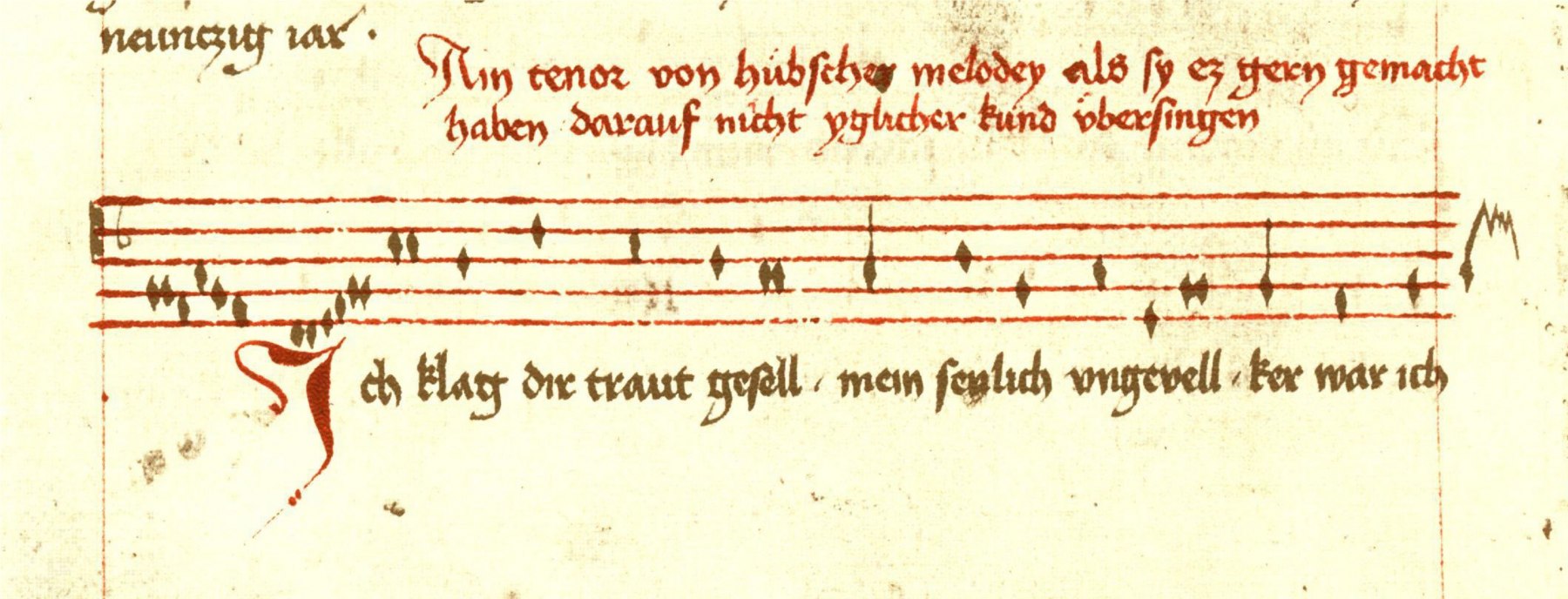A Panopticum of Medieval Song
The fifty-seven secular songs attributed to the Monk of Salzburg constitute one of the most important corpora of vernacular German song in the later Middle Ages. [1] They form one half of an extensive œuvre, the remainder of which is made up of forty-nine religious songs, many of them translations of Latin sequences and hymns (on these see » B. Geistliche Lieder des Mönchs von Salzburg).[2] The secular songs consist of seven polyphonic compositions—the earliest notated vernacular secular polyphony in the German-speaking lands—and fifty monophonic pieces. Sixteen of the monophonic pieces have a repeating form that bears some similarity to the ballade, but which are most likely not descended from contemporary French formes fixes.[3] (» Chap. The Monk’s Refrain Songs). Twenty-four of the monophonic pieces have a strophic form without Stollen, three of which are labelled in the Mondsee-Vienna manuscript as a “tenor” (» Fig. Ich klag dir, traut gesell).
Although the melodies for these pieces are through-composed, this is not necessarily true of the texts, which show a taste for elaborate rhyme-schemes, and often indeed use something resembling bar form. This disparity has led Reinhard Strohm to suggest that “tenor” in fact implies a melody that was transmitted without words and could be underlaid with words at will.[4] The remainder of the secular songs have idiosyncratic forms that evade classification. The Monk uses these forms to create songs that engage with various topics, including the life of the courtier, as well as the problems facing lovers, most prominently separation and the klaffer, the people who spread rumours at court. Some songs, such as the polyphonic Martinmas songs W54* Wolauf, lieben gesellen unverczait and W55* Martein, lieber herre and New Year songs such as W29 Ain gelügkleich iar nach deiner gier, are tied to particular seasons or festivals, but the majority are not occasional.
This article was written in the context of the ERC project ‘Music and Late Medieval European Court Cultures’ at the University of Oxford. This project has received funding from the European Research Council under the European Union’s Horizon 2020 research and innovation programme (grant agreement no. 669190).
[1] Edition: März 1999. März gives a complete edition of the text and music of the secular songs as well as extensive commentary and interpretations for every piece. His edition is also valuable for reproducing ill-accessible manuscript sources. “W” numbers in the following refer to this edition.
[2] For the religious songs, see the edition Spechtler 1972 for the text. “G” numbers in the following refer to this edition. Spechtler’s edition should be used alongside the corrections proposed in Wachinger 1989. For the music of the religious songs, see Waechter 2004.
[3] On these refrain songs, which Christoph März labelled “Virelai/Ballade”, see März 1999, 19–30, and Lewon 2018, 223–225.
[4] See Lewon 2018, 225.
